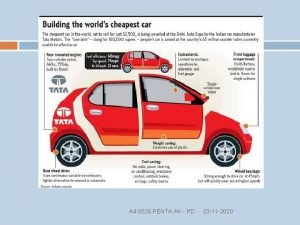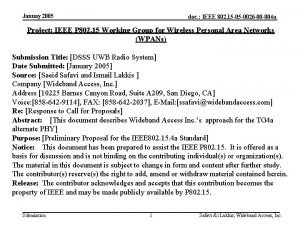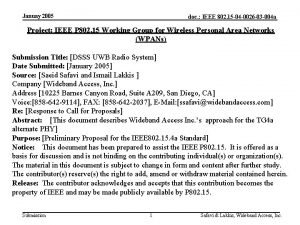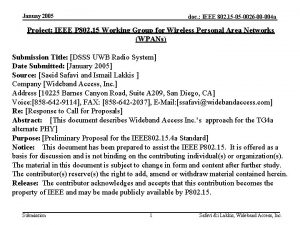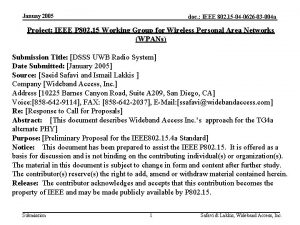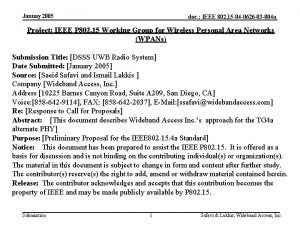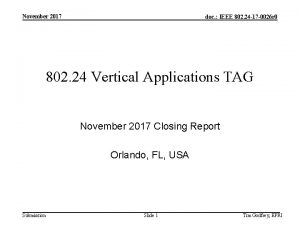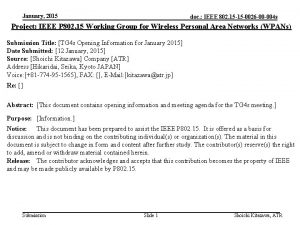Januay 2005 doc IEEE 802 15 05 0026











- Slides: 11

Januay 2005 doc. : IEEE 802. 15 -05 -0026 -00 -004 a Project: IEEE P 802. 15 Working Group for Wireless Personal Area Networks (WPANs) Submission Title: [DSSS UWB Radio System] Date Submitted: [January 2005] Source: [Saeid Safavi and Ismail Lakkis ] Company [Wideband Access, Inc. ] Address [10225 Barnes Canyon Road, Suite A 209, San Diego, CA] Voice: [858 -642 -9114], FAX: [858 -642 -2037], E-Mail: [ssafavi@widebandaccess. com] Re: [Response to Call for Proposals] Abstract: [This document describes Wideband Access Inc. ’s approach for the TG 4 a alternate PHY] Purpose: [Preliminary Proposal for the IEEE 802. 15. 4 a Standard] Notice: This document has been prepared to assist the IEEE P 802. 15. It is offered as a basis for discussion and is not binding on the contributing individual(s) or organization(s). The material in this document is subject to change in form and content after further study. The contributor(s) reserve(s) the right to add, amend or withdraw material contained herein. Release: The contributor acknowledges and accepts that this contribution becomes the property of IEEE and may be made publicly available by P 802. 15. Submission 1 Safavi &i Lakkis, Wideband Access, Inc.

Januay 2005 doc. : IEEE 802. 15 -05 -0026 -00 -004 a Wideband Access, Inc. Preliminary Proposal for IEEE 602. 15. 4 a Alternate PHY DSSS UWB Radio System Saeid Safavi & Ismail Lakkis Submission 2 Safavi &i Lakkis, Wideband Access, Inc.

Januay 2005 doc. : IEEE 802. 15 -05 -0026 -00 -004 a Proposal Summary • A robust direct sequence spread spectrum radio with large processing gains is proposed. • Despite its robustness the radio has a very simple and implementable architecture which is anticipated to support the size, cost and power consumption requirements of the alt. PHY. • Using DSSS, channel coding and a high receiver sensitivity, the system provides extended coverage well beyond 30 m. • The radio design supports all of the technical requirements of TG 4 a. Submission 3 Safavi &i Lakkis, Wideband Access, Inc.

Januay 2005 doc. : IEEE 802. 15 -05 -0026 -00 -004 a Advantages • Simple Architecture: – Facilitates manufacturability and time to market • Low Power Consumption: – Low rate ADC – CMOS technology • Low Cost: – Single chip implementation • Small Size: – Compact architecture – Minimal usage of external components • Extended Range: – Large processing gain – Improved receiver sensitivity – FEC • • Resistant to Interference, Multipath and Frequency Offsets Proven Location Awareness Methodology Submission 4 Safavi &i Lakkis, Wideband Access, Inc.

Januay 2005 doc. : IEEE 802. 15 -05 -0026 -00 -004 a System Block Diagram (Transmitter) Information Bits 1 kb/s-1 Mb/s BPSK Mod & Channel Coding 1. 024 Gcps Radio Channel 2 Stage Spreading BPF ~ A 4 GHz (50 ppm) Integrator Recovered Bits (2 nd Despreader) Submission Channel Decoding & Data Detection Integrator ADC * LNA (1 st Despreader) BPF Tb Differential Detector (Receiver) 5 Template Generator 4 GHz (50 ppm) Safavi &i Lakkis, Wideband Access, Inc.

Januay 2005 doc. : IEEE 802. 15 -05 -0026 -00 -004 a Distinctive Radio Features • • • • • Data Rates: 1 kb/s to 1 Mb/s BW: 1. 8 GHz (3. 1 – 4. 9 GHz) Chip Rate: 1. 024 Gcps Local Oscillator Offset: 50 ppm High Processing Gain: 30 d. B @ 1 Mb/s to 60 d. B @ 1 kb/s Link Margin: 3 d. B gain over OOK Extended Range: due to large processing gain, low sensitivity and FEC the range is significantly larger than 30 m Robust: robustness against noise and phase reversal errors, and high interference resistance due to large processing gain Low Levels of Interference to other systems: Due to the usage of DSSS with large processing gains Single low-power CMOS chip ADC operation at bit rate (rather than chip rate) and Small Size ADC (1 - 2 bit) Simple and Cheap Implementation (no expensive components such as SAW filters, etc. ) Wide Dynamic Range High Frequency Efficiency: due to efficient use of frequency within the band Precise Ranging Procedure: based on TOA Simple Signal Acquisition and Synchronization Support of large LO offsets: due to the differential detection Scheme Support of Intra-cell mobility Low Interchip Interference: An excellent code cross-correlation through usage of a subset of Kasami codes Submission 6 Safavi &i Lakkis, Wideband Access, Inc.

Januay 2005 doc. : IEEE 802. 15 -05 -0026 -00 -004 a Properties of Kasami Sequences • The small set of Kasami sequences is an optimal set of binary sequences with respect to the Welch Bound • For 1 Mbps: – – Sequence length: 1023 Number of possible sequences 32 Max. Autocorrelation SLL: 33 Max. Cross-correlation level: 33 • For lower data rates a 2 nd level of spreading is introduced using the same set of Kasami sequences (further increasing the processing gain) Submission 7 Safavi &i Lakkis, Wideband Access, Inc.

Januay 2005 doc. : IEEE 802. 15 -05 -0026 -00 -004 a Link Budget Parameter Mandatory Optional Peak payload bit rate (Rb) 1 kb/s 1000 Kb/s Average Tx power (Pt) -10. 00 d. Bm Tx antenna gain (Gt) 0 d. Bi Geometric center frequency of waveform (fc) 3. 944 GHz Path loss at 1 meter (L 1) 44. 36 d. B 29. 54 d. B at d = 30 m 20. 00 d. B at d = 10 m Rx antenna gain (Gr) 0 d. Bi Rx power (Pr) -83. 91 d. Bm -74. 36 d. Bm -143. 80 d. Bm -113. 80 d. Bm 7 d. B -136. 80 d. Bm -106. 80 d. Bm Minimum Eb/N 0 (S) 8 d. B Implementation Loss ( I ) 3 d. B Link Margin 41. 89 d. B 21. 44 d. B Proposed Min. Rx Sensitivity Level -125. 80 d. Bm -95. 80 d. Bm Path loss at dm (Ld) Average noise power per bit: ( Rx Noise Figure ( ) Average noise power per bit ( Submission ) ) 8 Safavi &i Lakkis, Wideband Access, Inc.

Januay 2005 doc. : IEEE 802. 15 -05 -0026 -00 -004 a Coexistence and Interference Susceptibility • Due to the usage of a simple DSSS scheme with no frequency or time hopping, the interference to the neighboring systems is minimal (resulting in low levels of both instantaneous as well as average interference). satisfying the TG 4 a’s coexistence requirements • DSSS with large processing gain would also ensures robustness against interfering devices, hence a high interference susceptibility. Submission 9 Safavi &i Lakkis, Wideband Access, Inc.

Januay 2005 doc. : IEEE 802. 15 -05 -0026 -00 -004 a Location Strategy • The location strategy is based on Time of Arrival (TOA). This method involves measuring the time of arrival of a known signal from the mobile device at three or more reference nodes. • The position can be calculated at the server location based on hyperbolic trilateration. More specifically, the location estimate is derived from the value of the Geometric Time Difference (GTD) between the time of arrivals at each node and a known time reference. Submission 10 Safavi &i Lakkis, Wideband Access, Inc.

Januay 2005 doc. : IEEE 802. 15 -05 -0026 -00 -004 a Conclusions • The DSSS system proposed herein is a simple and implementable radio that through its counter measures against, fading, noise and interference can provide the robustness and extended range (well above 30 m) required by TG 4 a. • The location awareness methodology based on TOA provides a precision ranging capability. • This system can be integrated in a compact CMOS chip with minimal external components and hence is a small-size, lowcost device. This combined with the radio robustness and location accuracy can support various 802. 15. 4 a applications. • The simplicity and the proven modulation techniques used ensures feasibility and scalability of the radio. • FFD’s and RFD’s for different applications can be supported due to the scalability provided by a long range of spreading codes. Submission 11 Safavi &i Lakkis, Wideband Access, Inc.
